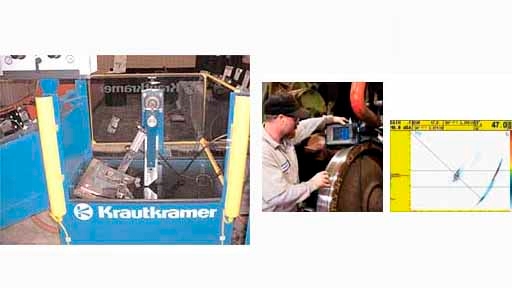Ultrasonic Testing

Ultrasonic testing is a non-destructive testing procedure that uses ultrasonic waves to inspect components made of sound-conducting materials for internal defects. Ultrasound refers to frequencies between about 20 kHz and 1 to 10 GHz that are above the frequency range perceivable by human hearing. Automated ultrasonic testing is used for non-destructive 100% inspection of internal material defects as well as for measuring and testing layer thicknesses of functional and safety-critical components. The test methods are based on the runtime measurement of sound waves that are emitted by an ultrasound source and whose reflections are picked up by sound sensors. Mistakes like inclusions, cracks, blowholes, separating points or the occurrence of interfaces cause a different reflection behavior of the sound waves. By evaluating the runtimes, it is possible to detect types and positions of errors that deviate from known nominal values or measure wall thicknesses, layer thicknesses and hardness depths. Objects or errors greater than half the wavelength of the sound can be detected only. For measurement, the workpiece surface is wetted with a couplant medium or the testing part is immersed in a suitable liquid for sound transmission. In the reflection sound method, the test head consists of an ultrasonic source and sound sensors and runs the surface touching manually or automatically by a handling system. The angle probe, mounted at a defined angle, emits sound pulses, which are either reflected from the back wall of the sample or from separation points, cracks or boundary layers. From the known speed of sound, which depends on the materials to be tested, the sound angle, the temperature and other coefficients, the distance to the reflection can be calculated from the runtime of the pulse. The method is suitable basically for all sound conductive materials, such as mostly all kinds of metal. Typical tasks are the material testing of welds, cast parts and forged parts, semi-finished products or pipes. Further areas of application include measurement of wall and layer thicknesses of plastic fuel tanks, testing of the hardening depth of forged and inductive, flame or laser hardened crankshafts, quick-release axles, steering push rods, cardan shafts and drive shafts. The test system can replace the destructive and complex hardness depth measurement by sawing the components with subsequent inspection of the grinding pattern. Another area of application is the examination of inner surfaces that are not accessible. User industries include the automotive and automotive supply industries, foundries and manufacturers of containers and semi-finished products.
Products: Ultrasonic Testing
Suppliers: Ultrasonic Testing
| GE Inspection Technologies | |
| Hillger NDT GmbH | |
| KARL DEUTSCH Prüf- und Messgerätebau GmbH & Co. KG | |
| MACEAS GmbH, 26676 Harkebrügge, Germany | |
| Quality Material Inspection, Inc | |
| ScanMaster Systems, Ltd. | |
| Sonatest Plc | |
| Vogt Ultrasonics GmbH |




